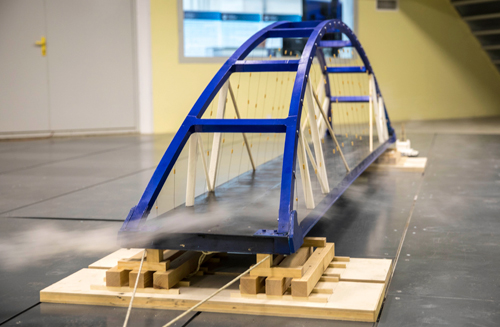
Mathematical and experimental modeling of the operation for transportation of Crimea Bridge’s navigation arches (highway and railway) were carried out at the Krylov State Research Centre in Saint Petersburg. The assembled arches will be delivered from the Kerch side to the midstream supports to be installed as designed. During tests, KSRC specialists had to determine the maximum values of wind speed, current and sea state as well as the number and arrangement of tugs to perform this operation.
The mockups of navigation arches (scale 1:60), pontoons for their transportation and tugs were manufactured for the purposes of the experiment. The delivery of arch spans to the installation site is a challenging task. Firstly, highway and railway arches are the largest and the heaviest structures of the Crimea Bridge, their total weight is about 10 thousand tons, and the length of each arch is 227 meters. Secondly, the shallow depth of the Kerch Strait is almost compatible with the pontoon draft. Thirdly, the Kerch-Enikalsky Channel is characterized by strong winds and high seas.
Tests aimed to determine the wind load were performed taking into consideration all possible wind directions and speeds. For this purpose, the arch model was rotated by 360 degrees using the turntable inside the landscape wind tunnel. The outcome of this test was of great importance. Navigation spans for the Crimea Bridge can be transported only at wind speed less than 10 meters per second. The arrangement and number of tugs may vary. There are at least three variants of tugs arrangement, for example: one tug with towing bridle at the fore end and two tugs at the aft end. Whereas the resistance and aerodynamic loads obtained for the railway arch are greater, the larger and more powerful tugs are required for its transportation.
Upon the completion of the experimental part, the specialists started to develop the mathematical model. All the data, i.e. the wind loads obtained in landscape wind tunnel, hydrodynamic characteristics obtained at the KSRC test tank, and the specifics of the Kerch Strait are considered in this model also used to trace out pontoons trajectory- from roll-out jetties to the midstream supports. Special simulator complex enables simulation of the operation for transportation of navigation spans taking into account all specified parameters. Each work place in this complex simulates tug control panel.
The simulator complex enables to display the position of transported system with allowance for all external forces on a real-time basis. The operation leader instructs all the ship drivers. It is necessary to keep the transportation system consisting of the ach, pontoons and tugs within the navigation channel. Wind, current, waves or the combination of these external factors may force the system out of the channel.
Navigation spans will be transported to the installation site precisely along the specified trajectory. Dredging activities are carried out at the Kerch coast in order to ensure free passage of the system en route. The complex intended for transportation of arches is under construction at «Sevmorzavod» in Sevastopol. It consists of four pontoons joined together as catamarans. They are fitted with special mechanisms aimed both to deliver the navigation spans to the installation site and to lift them up to 35 meters for installation as designed.
Navigation arches of the Crimea Bridge are currently being assembled on the slipways at the Kerch side. Over 6 500 tons of metal structures have been assembled already. It is 65% of the total work scope. The roll-out jetties intended for moving the structures to the water and placing on the pontoons are under construction at the same site. The activities aimed to enlarge the spans are carried out on the round-the-clock basis. Over 500 people are involved. The transportation of the arches to the installation site is scheduled for late August-early September 2017. It should take about 3 days according to the plan.